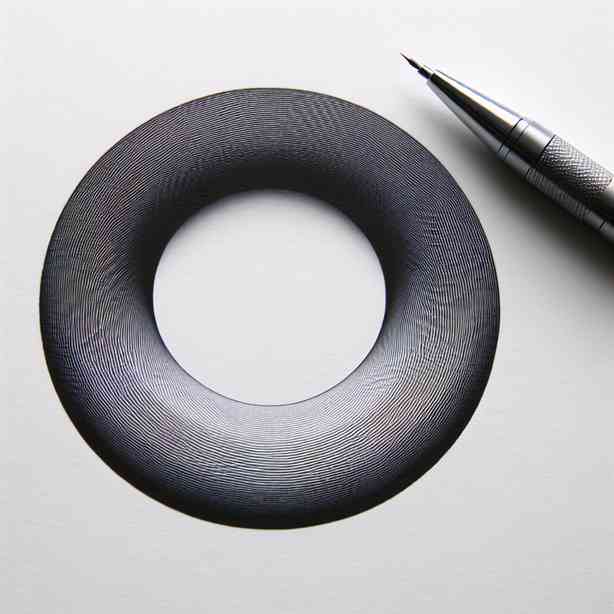
Drawing a perfect circle freehand is an enchanting and often overlooked skill that brings with it a profound sense of accomplishment and joy. While it may seem like a simple task, the process of creating a circle without the aid of tools can be both challenging and rewarding. This act can reflect not only one’s artistic abilities but also one’s inner state of being. In this exploration of the joy of freehand circle drawing, we will delve into the significance of this endeavor, the techniques involved, the emotional aspects associated with it, and how it can enhance our overall well-being.
The circle, as a geometric shape, holds a special place in various cultures and philosophies. Symbolizing unity, wholeness, and infinity, circles appear in nature and human creation alike—a reminder of the interconnectedness of life. When we take the time to focus on drawing a perfect circle by hand, we enter into a meditative state, allowing our minds to quiet and our creativity to flow. This creative endeavor not only grounds us but also connects us to a rich history of artistic expression.
To begin the journey of mastering the art of drawing a circle freehand, one should consider several techniques that can aid in achieving a more symmetrical result. The importance of practice cannot be overstated; as with any skill, consistency will yield noticeable improvements. One practical method is to visualize the circle before committing it to paper. This mental picture can serve as a guide, providing a reference point for your hand as it moves across the surface.
Another effective technique is to use your wrist as a pivot point. By anchoring your wrist down and moving your arm in a circular motion, you can maintain a more fluid and controlled line. Additionally, engaging your shoulder can aid in making larger circles, adding a sense of dynamism to your drawing. As you practice these movements, you may find that your confidence grows, reflecting in the circles you create.
Moreover, remember that drawing a circle is not just about achieving perfection on the first try. It’s a process of exploration and learning. Embrace the imperfections, for they contribute to the uniqueness of your artwork. Each attempt reveals something new about yourself—your strengths, your areas for improvement, and your evolving style. This journey of self-discovery through art can be incredibly fulfilling.
The emotional landscape associated with drawing circles freehand is rich and multifaceted. Many individuals report feelings of joy, peace, and satisfaction when they see their hand produce a circle that matches their vision. This sense of accomplishment can boost self-esteem and foster a positive mindset. In a world where perfection is often sought after but rarely achieved, the act of drawing a circle freehand becomes a beautiful metaphor for acceptance and progression.
Additionally, engaging in artistic activities such as drawing circles can serve as a form of mindfulness practice. The focus required to draw a circle can detract from distractions, anchoring us in the present moment. This practice of mindfulness has been shown to reduce anxiety, improve concentration, and foster emotional resilience. Therefore, dedicating time to draw circles can serve as an accessible way to incorporate mindfulness into our daily routine.
As we explore the significance of circles in various cultures, we find that they often represent cycles and the passage of time. In nature, we see circles in the growth rings of trees, the orbits of planets, and the formation of water ripples. In various spiritual traditions, circles are used in rituals and ceremonies to symbolize eternity and the cyclic nature of life. Understanding these connections can deepen our appreciation for the act of drawing a circle and its symbolic weight.
It’s also important to mention the communal aspect of this activity. Engaging with others in drawing circles can foster a sense of camaraderie and shared experience. Whether you join a workshop, invite friends to draw together, or participate in an online forum, this collaborative spirit enriches the practice. Sharing your progress, seeking feedback, and encouraging each other boosts motivation and provides a supportive environment for artistic growth.
In recent years, the trend of art therapy has gained traction, further highlighting the therapeutic benefits of creative expression. Drawing circles can be a part of such therapeutic practices. Art therapists recognize that creating art facilitates emotional expression and can serve as a coping mechanism for stress and trauma. By focusing on the simple task of drawing circles, individuals may find it easier to convey complex feelings and thoughts that might be difficult to articulate verbally.
As we have seen throughout this exploration, drawing a perfect circle freehand encompasses more than just the act of creating a geometric shape. It is an invitation to adventure—an exploration of imagination, self-acceptance, and emotional growth. While achieving perfection in technique is a worthy goal, the true joy lies in the journey itself. Each circle drawn offers a new lesson, a new challenge, and a new opportunity to connect with ourselves and the world around us.
In conclusion, drawing a perfect circle freehand encapsulates a rich tapestry of experiences that nurture our creativity, foster mindfulness, and cultivate emotional resilience. As individuals embark on this artistic journey, they not only hone their technical skills but also engage in a reflective practice that can enhance their sense of well-being. So, the next time you find yourself with a blank canvas or a sheet of paper, consider picking up your pen or pencil and allowing your hand to explore the vibrant world of circles. Who knows? You might just discover joy in the imperfect beauty of your freehand artistry.


